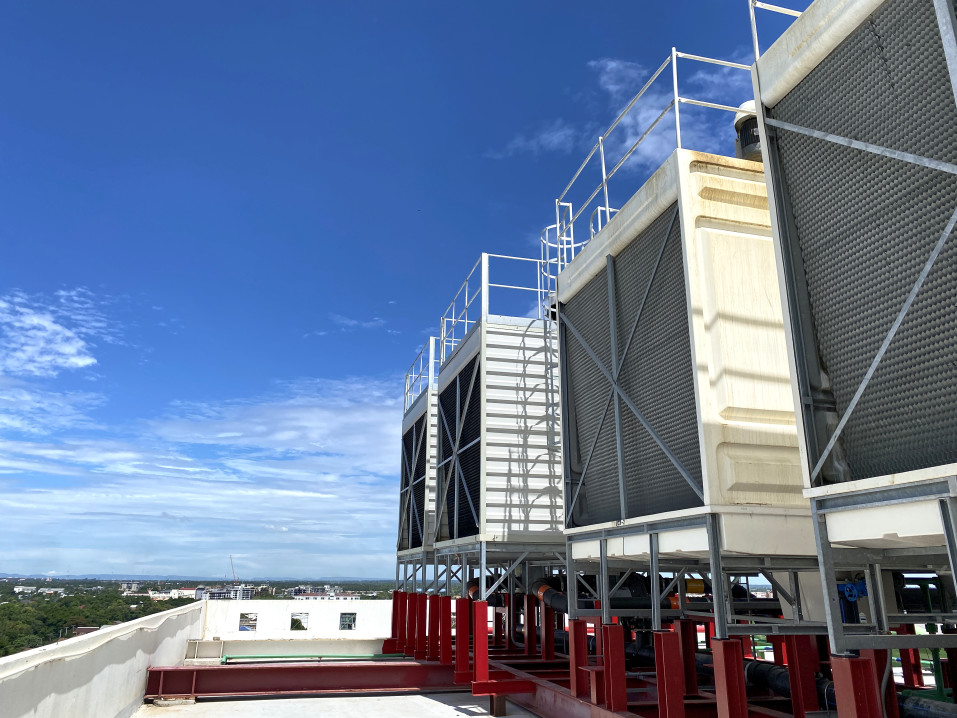Environmentally Friendly Cooling Tower Operations

When it comes to large commercial HVAC operations, cooling towers are essential. The use of water to transfer heat allows for much more efficient cooling than when using air. However, do cooling towers have any negative effects on the environment? When thinking about this, it’s important to understand how cooling towers function, ways in which they can impact the environment, and best practices to ensure that the impact is limited when possible. Installing and operating environmentally-friendly cooling towers takes industry expertise, adequate training, and preventative measures so that towers run as “green” as possible.
How Cooling Towers Work
Cooling towers are essentially heat exchangers, which send unwanted heat back into the atmosphere through the use of some type of coolant stream. The most common coolant is cooled water. While there are several cooling tower types and configurations, the overall effect is the same. Heat is sent away from HVAC systems into the environment to keep the temperature within those systems at a safe and operable level. In operating a cooling tower, water is brought in from external sources and either leaves the tower by evaporation due to the cooling process or is recycled through the unit.
The Impact of Cooling Towers on the Environment
The use of cooling towers allows for HVAC systems to operate more safely and efficiently as it reduces overheating. However, this cooling process doesn’t come without certain effects on the environment. The most obvious is the use of water in the cooling process. When thinking about large cooling towers used in power plants and large manufacturing facilities, the amount of water needed can be extensive. The steady flow of water is what keeps the heat rejection process in motion. Some operators look to nearby water sources to source this water, including lakes and rivers. If extracted irresponsibly, taking water from these sources can have damaging effects on their ecosystems.
In addition to water consumption, cooling towers need electricity to power fans, chillers, and pumps. Starting and stopping pumps within a cooling tower can use an excess of electricity if not adequately controlled.
Lastly, cooling towers can be a breeding ground for bacteria and microorganisms. One of the most dangerous occurrences is the presence and growth of the bacteria Legionella, which can cause Legionnaires disease, among other health issues. To prevent or reduce bacteria growth, many cooling tower operators rely on chemical treatments that, while effective in stopping bacteria growth, can also have negative environmental effects.
Strategies for Reducing Environmental Impact
Presently, there is no way to eliminate the environmental effects of cooling towers. However, there are several ways in which to reduce that impact and operate cooling towers most sustainably.
Invest in Preventative Maintenance
Routine, preventive maintenance helps to keep cooling towers in top working condition for years. Additionally, it can help significantly reduce the negative environmental effects of tower operation. Firstly, preventive maintenance can help maximize the cycles of concentration within a tower. A cycle of concentration refers to the number of times that the concentration of dissolved solids in the water multiplies (compared to when it enters the tower as makeup water. Some water evaporates during the cooling process, so the water left behind to recirculate contains a higher amount of dissolved solids over time. Maximizing these cycles of concentration means lowering the amount of makeup water needed (and essentially, overall water consumption of the unit). Effective preventive maintenance that helps to achieve ideal cycles of concentration include treatments for corrosion and scaling.
Preventative treatments for bacterial growth also limit the need for using environmentally harsh chemicals to treat growth after it escalates. Bacteria growth not only produces health concerns. It also often hides deterioration underneath which can lead to the breakdown of vital parts within the tower. Overall, preventive maintenance versus reactive maintenance means less reliance on harsh chemical treatments and better control over the amount of water used by the cooling tower.
Utilize VFDs
When thinking about reducing electricity consumption in towers, variable frequency drives (VFDs) are a wise investment. As previously mentioned, starting and stopping tower components, such as condenser pumps, consumes a large amount of electricity. Switching from conventional motors to VFDs means better control over energy consumption. VFDs reduce electricity needs in two ways. First, they only deliver the required amount of electricity needed by a component. Also, they don’t have to continuously start motors, which often uses more electricity than actually running them for the required amount of time.
Ensure Tower Operators are Trained Effectively
Even the most efficiently designed and maintained cooling tower requires operators who are well versed in each tower component and how it functions. Problems that arise in cooling towers often do so in the form of small issues to start. Having a team of operators on board who knows what to look for when identifying issues means they will be able to be mitigated sooner, with less of an impact environmentally. Treatments like replacing entire tower components due to corrosion bring in a whole other level of environmental impact. You have to consider the manufacturing that went into producing those pieces. Preventing as many large-scale issues ultimately means a tower will run much more sustainably over time.
Preventive Maintenance and Training from Cooling Tower Experts
Having the right knowledge and experience on your team is the first step to sustainable cooling tower operations. Whether you want to train your team to handle maintenance in-house or would rather set up a preventive maintenance plan with external professionals, Cooling Tower Experts is here to help. We offer a variety of services, including training and consultation as well as maintenance services. We’ve gathered a team of true industry experts who each bring years of experience to the table. If you’d like to assess your tower operations and discuss how to make them more sustainable and environmentally friendly, we’d love for you to reach out!